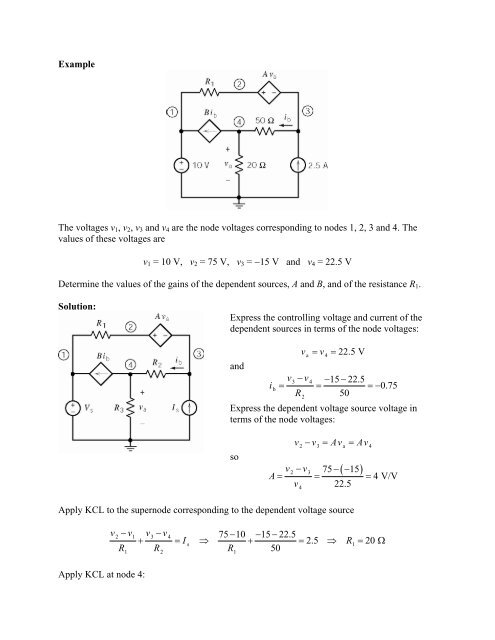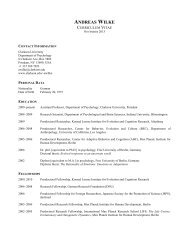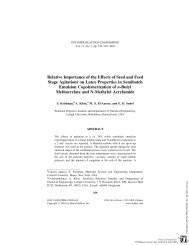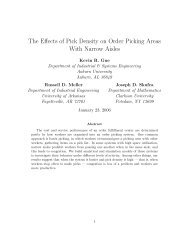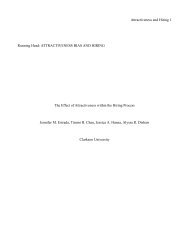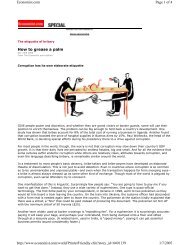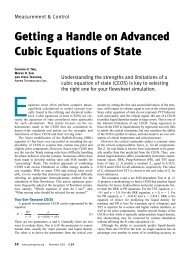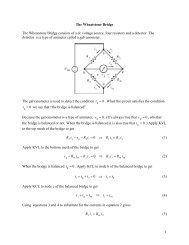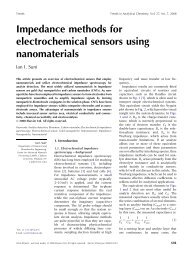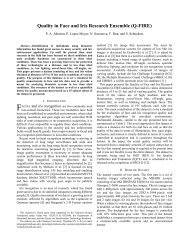node voltages or mesh currents
node voltages or mesh currents
node voltages or mesh currents
You also want an ePaper? Increase the reach of your titles
YUMPU automatically turns print PDFs into web optimized ePapers that Google loves.
Example<br />
The <strong>voltages</strong> v1, v2, v3 and v4 are the <strong>node</strong> <strong>voltages</strong> c<strong>or</strong>responding to <strong>node</strong>s 1, 2, 3 and 4. The<br />
values of these <strong>voltages</strong> are<br />
v1 = 10 V, v2 = 75 V, v3 = −15 V and v4 = 22.5 V<br />
Determine the values of the gains of the dependent sources, A and B, and of the resistance R1.<br />
Solution:<br />
Express the controlling voltage and current of the<br />
dependent sources in terms of the <strong>node</strong> <strong>voltages</strong>:<br />
and<br />
i<br />
b<br />
va = v4<br />
= 22.5 V<br />
v3−v4 −15 −22.5<br />
= = =− 0.75<br />
R 50<br />
2<br />
Express the dependent voltage source voltage in<br />
terms of the <strong>node</strong> <strong>voltages</strong>:<br />
so<br />
v2 − v3 = Ava = Av4 4<br />
( )<br />
v2 − v3<br />
75 − −15<br />
A = = = 4 V/V<br />
v 22.5<br />
Apply KCL to the super<strong>node</strong> c<strong>or</strong>responding to the dependent voltage source<br />
Apply KCL at <strong>node</strong> 4:<br />
v −v v −v 75 −10 −15 −22.5<br />
+ = ⇒ + = 2.5 ⇒ = 20 Ω<br />
2 1 3 4<br />
Is R1<br />
R1 R2 R1<br />
50
v3−v4 v4 v3−v4 −15 −22.5 22.5 −15−22.5 = + B ⇒ = + B<br />
⇒ B = 2.5 A/A<br />
R R R<br />
50 20 50<br />
2 3 2<br />
Example<br />
The value of the <strong>node</strong> voltage at <strong>node</strong> b in the circuit is v b = 18 V.<br />
(a) Determine the value of A, the gain of the dependent source.<br />
(b) Determine the power supplied by the dependent source.<br />
Solution<br />
(a) Express the controlling voltage of the dependent source in terms of the <strong>node</strong> <strong>voltages</strong>:<br />
Apply KCL at <strong>node</strong> b to get<br />
v = 9 − v<br />
a b<br />
9−vb vb 18−3vb<br />
= A( 9 − vb) + ⇒ A=<br />
= 0.02<br />
100 200 200 9<br />
(b) The power supplied by the dependent source is<br />
( Av ) v ( )<br />
( )( )<br />
( − v b )<br />
− a b =− 0.02 9 − 18 18 =<br />
3.24 W
Example<br />
The <strong>currents</strong> i1, i2 and i3 are the <strong>mesh</strong> <strong>currents</strong> c<strong>or</strong>responding to <strong>mesh</strong>es 1, 2 and 3. The values of<br />
these <strong>currents</strong> are<br />
i1 = −1.375 A, i2 = −2.5 A and i3 = −3.25 A<br />
Determine the values of the gains of the dependent sources, A and B.<br />
Solution:<br />
Express the controlling voltage and current of the dependent sources in terms of the <strong>mesh</strong><br />
<strong>currents</strong>:<br />
v = 20 i − i = 20 −1.375 − − 2.5 = 22.5<br />
and<br />
( ) ( ( ) )<br />
a 1 2<br />
( )<br />
ib = i3− i2<br />
=−3.25 − − 2.5 =− 0.75 A<br />
Express the current source <strong>currents</strong> in terms of the <strong>mesh</strong> <strong>currents</strong>:<br />
and<br />
i = − 2.5 A<br />
2<br />
( ) ( )<br />
i3− i1 = Bib ⇒ −1.375 − − 2.5 = B −0.75 ⇒ B=<br />
2.5 A/A<br />
Apply KVL to the super<strong>mesh</strong> c<strong>or</strong>responding to the dependent current source<br />
3 a b a<br />
( ) ( ) ( )<br />
0 = 20 i + Av + 50 i + v − 10 = 20 − 3.25 + A 22.5 + 50 − 0.75 + 22.5−10⇒ A=<br />
4 V/V


